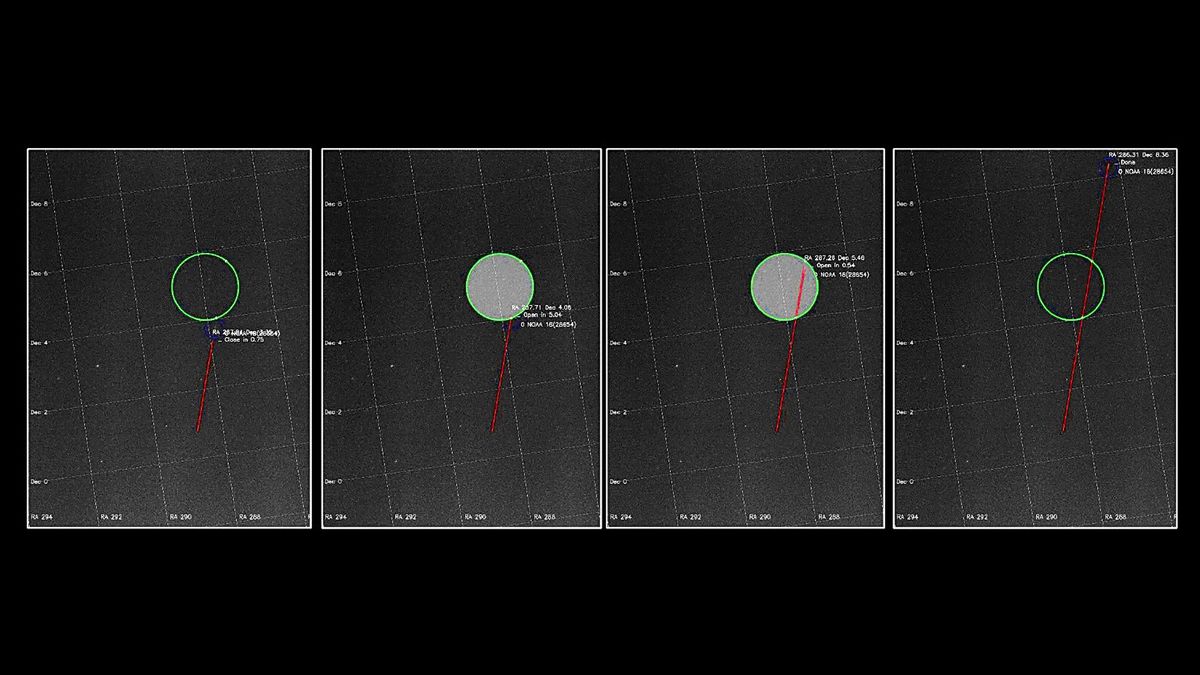
A Russian startup is testing a technology that filters out disruptive passes of SpaceX’s Starlink satellites from astronomical observations.
Developed by St. Petersbourg, Russia-based Stealth Transit, the technology detects bright approaching satellites and closes the telescope’s shutter to prevent the spacecraft from ruining the image.
In a statement emailed to Space.com, the company said the technology works with narrow and medium field of view telescopes, both professional and amateur, that cover no more than one square degree of the sky. Wider fields of view could be affected by multiple satellites at once, which makes this solution impractical, Stealth Transit said in the statement.
However, the company’s CEO, former telecommunications engineer Vlad Pashkovsky, told Space.com that wide field of view telescopes, such as the Vera C. Rubin Observatory in Chile, which has a field of view of 9.6 square degrees, could still partially benefit from the technology.
Related: SpaceX Starlink satellites responsible for over half of close encounters in orbit, scientist says
“The StealthTransit approach allows us to protect certain areas of a wider field of view, ones which are most important for the observation,” Pashkovsky said.
The company recently started testing the technology at one of Russia’s most advanced astronomical observatories, the Caucasus Mountains Observatory near Kislovodsk, in southwestern Russia.
The team installed its detector of bright satellites on an ASA 600 telescope that has a field of view of 22 by 22 arcminutes (one arcminute is one-sixtieth of a degree) and connected the detector to a Stealth Transit active shutter.
“The Stealth Transit detector recognizes low Earth orbit satellite trajectories and accurately predicts the time of transit of the satellite through the telescope’s field of view,” Pashkovsky said. “The shutter then interrupts the exposure of the astronomical camera in order to make the satellite transit invisible.”
Astronomers have lamented the unwanted visual effects of the Starlink internet-beaming satellites ever since SpaceX started lofting the first batches of its planned constellation into orbit in 2019. Circling Earth at the altitude of 340 miles (550 kilometers), the satellites reflect sunlight and create streaks in astronomical images. They also increase light pollution in regions that are known for otherwise perfect conditions for stargazing. Large and expensive international observatories located at these sites are thus at risk of fewer useful observation windows and diminishing returns on investment.
Earlier this year, The International Astronomical Union (IAU) initiated talks within the United Nations’s Committee on the Peaceful Uses of Outer Space (UN COPUOS) to protect the pristine night sky as human heritage.
SpaceX previously said they would work together with the astronomers to find a solution, but whatever has been done so far has been deemed insufficient by the scientific community. One of the solutions proposed by SpaceX was to coat the satellites with a non-reflective material to reduce the brightness. But Stanislav Karpikov, chief technical officer of StealthTransit, said in the statement that satellite brightness is mostly determined by the orientation of its reflective parts, for example solar arrays, relative to Earth and the sun.
Pashkovsky added that dimming coatings tend to affect the satellites’ thermal balance and therefore decrease their longevity.
“Reducing brightness is in conflict with the goals of ensuring the satellite’s performance and longevity,” Pashkovsky said. “The use of dimming coatings disturbs the thermal balance of the satellite and reducing the area of solar arrays or changing their orientation deprives the satellite of necessary energy.” However, he added that eventually satellites will become less bright as they become more compact.
Starlink satellites cause the most significant disruption shortly after launch when they travel in neat train-like formations as they are ejected from the rocket fairing. They eventually disperse as they reach their operational orbits but still remain visible even to relatively simple telescopes.
UN COPUOUS estimates that up to 40% of astronomical observations with wide-field telescopes could be ruined after SpaceX deploys all of the currently planned 12,000 satellites. The company envisions up to 40,000 satellites in the more distant future. SpaceX didn’t respond to a request for comment.
Nikolay Shatsky, the head of the Caucasian Mountain Observatory, which is testing the Stealth Transit tech, said Starlink affects even narrow field of view telescopes, especially when they search for near-Earth asteroids and comets during twilight hours.
“The risk of image damage increases with the launch of dozens of new LEO satellites monthly,” Shatsky said in the statement. “The risk factor is, according to our estimates, at least 5%. It is impossible to correct such images even with the help of processing. You have to reshoot and look for free windows in the observatory’s schedule to carry out repeated observations.”
However, he said, there is no guarantee that the repeated observations would not be affected.
Follow Tereza Pultarova on Twitter @TerezaPultarova. Follow us on Twitter @Spacedotcom and on Facebook.
from WordPress https://ift.tt/3jhl2Kw
via IFTTT

No comments:
Post a Comment